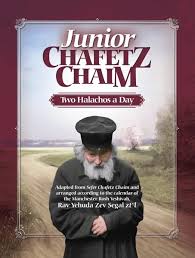By Rabbi Yair Hoffman for 5tjt.com
If seforim had a Pulitzer Prize – this Sefer would have clinched one. But the best kept secret of the newly penned “Junior Chofetz Chaim” (Israel Bookshop 2020, 277 pp) for children is that it is not exclusively for children at all. Wrapped in the guise of a children’s book is a scholarly work that captures the depth and breadth of the Chofetz Chaim’s original work on Shmiras HaLashon but in plain and simple English.
This is not just a work that will sell in the next year or two, or three. This will withstand the test of time and will be the “go-to sefer” on the topic because of a unique combination of four factors:
- Its strict adherence to the integrity of the Choftez Chaim’s text
- Its combination of conceptual depth and simplicity of language.
- Its day by day schedule broken up in a very workable 119 day cycle.
- The presentation of fascinating information in Kilcullen-esque text boxes
The author, although remaining in anonymity, is clearly a very serious Talmid Chochom because his translations (with no exception that this author has found) are remarkably accurate. Generally, a translator will sacrifice accuracy for readability. This author has found that perfect combination which sacrifices neither of the two – and for a children’s book – that is well-nigh impossible.
The main text brings to life, with contemporary examples, the concepts in the Chofetz Chaim’s original text. The examples are very relevant, vivid, and absolutely enthrall the reader. On page 132, for example, the author provides vivid illustrations of what constitutes an Apikores versus a Rasha. Aside from the vibrant examples in the text, the author conveys the depth of the original sefer with startling accuracy. The language is clear and simple too, but not to the extent that it sacrifices any depth.
The day by day schedule is broken up into 119 days – which, in a sense, creates a daf-yomi-like experience with completion of the sefer every four months. Doing it for a year – gives the young reader a veritable mastery over the entirety of Hilchos Lashon Harah and Rechilus.
Before we get to the fourth and final factor, lets recall the Chazal (Aicha Rabbasi 2:13) that tells us, “Chochma bagoyim taamin.” John Kilcullen, the founder of IDG books, discovered something that changed the world of printing and books. He discovered that shaded text-boxes that have names and interesting graphics – enhance readability, interest, and understanding. They also increase the attention span. The key is that they be short, hard-hitting, and to the point.
It works. And fabulously so. This Sefer has four such Kilcullen boxes – aptly named, “Words of Wisdom”; “Zoom In”; “Good Point”; and “Amazing Fact.”
Each of the four boxes contain remarkable information that could be read and thoroughly enjoyed on their own. Even if conversation only leads to Avak Lashon Harah [Avak and not full is the key here] it is still forbidden (Day 28 – Good Point); When trying to end a fight, the Mitzvah of rebuking is sometimes suspended because of the reaction it could cause – in that they will react aversely when they realize that you are rebuking them and not on their side – per se (Day 67 Good Point); The Amazing Fact boxes are also filled with, well, amazing facts. If a long time had past since you last were aware of his misdeeds, the tacit assumption you must make is that he had done a proper Teshuvah – and there are halachic repercussions and differences to this assumption (Day 41 Amazing Fact). The Gemorah in Arachin (15b) says that one who speaks lashon hara has no way to correct his sin. But isn’t there Teshuvah for everything? The Chofetz Chaims states that this Gemorah is referring to a fully active Baal lashon Harah who has made this his or her way of life. He has hurt so many people that it is a veritable impossibility to ask each and every one of them forgiveness for what he has done. The Gemorah is speaking practically (Day 47 Amazing Fact).
In short, this work is a masterpiece.
Is there a downside to this remarkable work? And if there was – would it be lashon harah to say it? This author thinks there is a downside, and that it is, in fact, not lashon harah. The downside is that to keep to the two pages a day – some of the daily sections continue on – in the back of the sefer. [Artscroll Gemorahs don’t do it, but Dirshu Mishna Brurah’s do.] Why is this not Lashon harah? Because, in this author’s view, the benefits of this remarkable work by far outweigh this drawback. [There are proofs to this idea – but beyond the scope of this review.] The material in the back section is also well worth the extra ten seconds it takes to flip to the back.
CONCLUSION
Go out and buy this book – even if you don’t have kids living at home who will enjoy it – because you will most certainly love it.
The reviewer can be reached at [email protected]











